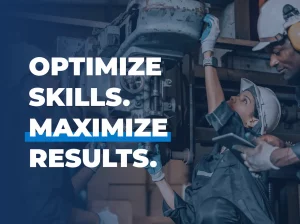
This program is excellent for training mechanics and millwrights as well as for the multi-craft needs of process and manufacturing facilities.
This lesson is designed for participants familiar with safe shop practices and the use of hand tools and precision measuring instruments.
This lesson explains the purpose of bearings and demonstrates how bearings reduce friction and maintain the alignment of operating equipment. The basic operation of anti-friction bearings and plain journal bearings is demonstrated as well as the importance of full fluid film lubrication and proper lubrication clearance. Additionally, indications of various premature bearing failures are discussed.
This lesson is designed for participants familiar with safe shop practices and the use of hand tools and precision measuring instruments.
This lesson explains the purpose of bearings and demonstrates how bearings reduce friction and maintain the alignment of operating equipment. The basic operation of anti-friction bearings and plain journal bearings is demonstrated as well as the importance of full fluid film lubrication and proper lubrication clearance. Additionally, indications of various premature bearing failures are discussed.
This lesson is designed for participants familiar with safe shop practices, the use of hand tools and precision measuring devices, as well as bearings failure analysis.
This lesson explains and demonstrates how to clean and disassemble bearing housings and how to dismount, inspect, and mount common types of bearings. The importance of cleanliness and following manufacturers’ instructions are stressed throughout each demonstrated procedure.
This lesson is designed for participants familiar with safe shop practices, the use of hand tools and precision measuring devices, as well as bearings failure analysis.
This lesson explains and demonstrates how to clean and disassemble bearing housings and how to dismount, inspect, and mount common types of bearings. The importance of cleanliness and following manufacturers’ instructions are stressed throughout each demonstrated procedure.
This lesson is designed for participants familiar with safe shop practices and the use of hand tools and precision measuring instruments.
This lesson explains the purpose of bearings and demonstrates how bearings reduce friction and maintain the alignment of operating equipment. The basic operation of anti-friction bearings and plain journal bearings is demonstrated as well as the importance of full fluid film lubrication and proper lubrication clearance. Additionally, indications of various premature bearing failures are discussed.
This lesson is designed for participants familiar with safe shop practices and the use of hand tools and precision measuring instruments.
This lesson explains the purpose of bearings and demonstrates how bearings reduce friction and maintain the alignment of operating equipment. The basic operation of anti-friction bearings and plain journal bearings is demonstrated as well as the importance of full fluid film lubrication and proper lubrication clearance. Additionally, indications of various premature bearing failures are discussed.
This lesson is designed for participants familiar with safe shop practices, the use of hand tools and precision measuring devices, as well as bearings failure analysis.
This lesson explains and demonstrates how to clean and disassemble bearing housings and how to dismount, inspect, and mount common types of bearings. The importance of cleanliness and following manufacturers’ instructions are stressed throughout each demonstrated procedure.
This lesson is designed for participants familiar with safe shop practices, the use of hand tools and precision measuring devices, as well as bearings failure analysis.
This lesson explains and demonstrates how to clean and disassemble bearing housings and how to dismount, inspect, and mount common types of bearings. The importance of cleanliness and following manufacturers’ instructions are stressed throughout each demonstrated procedure.
This comprehensive interactive multimedia training program consists of two individual lessons that train participants remove, inspect, select, handle, install, and troubleshoot bearings according to manufacturers’ instructions and best practices. Participants learn how to identify replacement bearings and install and maintain the bearings properly using the right tools.
This program is excellent for training mechanics and millwrights as well as for the multi-craft needs of process and manufacturing facilities.